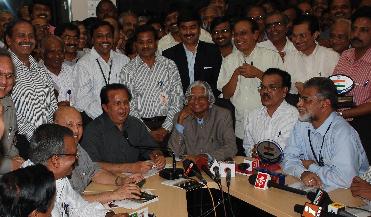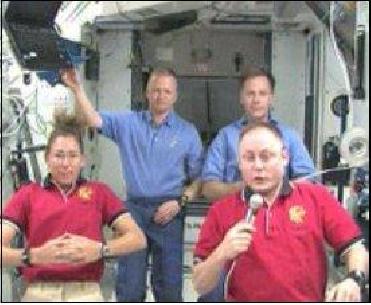
ISRO chief G Madhavan Nair (L) with former President Dr APJ Abdul Kalam flanked by ISRO scientists
THIRUVANANTHAPURAM (PTI): With the success of Chandrayaan-1, the country's first moon mission, the Indian Space Research Organisation (ISRO) is planning a manned space mission as a first step to manned moon mission.
"Sending man to moon is a very complicated mission. So, as a first step, we plan to develop an Indian spacecraft that will take astronauts across the Earth and bring them back," ISRO Chairman G Madhavan Nair said here while delivering a lecture on 'India's Recent Space Achievements' on Sunday.
The government�s approval to the mission is yet to be received and ISRO is planning the programme by 2015, Nair said.
"ISRO was also in the process of developing technologies for a manned moon mission and it would take more than six to seven years to develop those technologies," he said, adding: "Our effort is to achieve the milestone by the time the proposed next manned moon mission of USA and China materialises in 2020."
On the next Space programme, the ISRO chief said government has sanctioned Chandrayaan-2 mission which would be launched in 2012 and work on it has started. Under the programme, a robotic lunar rover would smooth land on the moon and conduct experiments, he added.
"Adithya is another space programme in the pipeline. Under this programme, efforts would be made to study the Solar System by launching a satellite and the same would be stationed within the Earth�s orbit."
"There was no plan to send any satellite to the Sun," Nair said, referring to media reports that ISRO was planning a Sun Mission.
On the functioning of Chandrayaan-1, Nair said cameras fitted in the satellite had already taken 3,000 colour pictures of different areas of the moon, adding, analysis of the pictures sent by the satellite was in progress and information gathered so far has been useful for future space programmes.
The payload that would explore whether moon has water would be put into operational mode soon, he said, adding there were signals that gave the deposits of minerals on moon.
Terming as �treasure house� the information gathered through Chandrayaan-1 mission so far, Nair said some of the pictures of the moon were �very scary�.
In a lighter vein, he said many people compare their sweetheart's face and body with the moon�s surface. �But I do not think that they will do the same after seeing some of the pictures taken at a very close range by the high resolution cameras of Chandrayaan-1".
ISRO was also in the forefront of taking its scientific achievements to common man's needs, Nair said referring to the advancements made in the tele-medicine and telecommunication sector.
Scientists behind the Chandrayaan-1 mission -- K Radhakrishnan, Director, Vikram Sarabhai Space Centre (VSSC), V Adimurthy, Associated Director, VSSC, George Koshy, Mission Director, PSLV-C11, were honoured on the occasion.
The lecture was organised by the Kshartriya Kshema Sabah on the occasion of 113th birth anniversary of Regent Maharani Sethu Lakshmi Bai of erstwhile Travancore royal family.
 Next Article
Next Article













The Indian Air Force, in its flight trials evaluation report submitted before the Defence Ministry l..
view articleAn insight into the Medium Multi-Role Combat Aircraft competition...
view articleSky enthusiasts can now spot the International Space Station (ISS) commanded by Indian-American astr..
view article